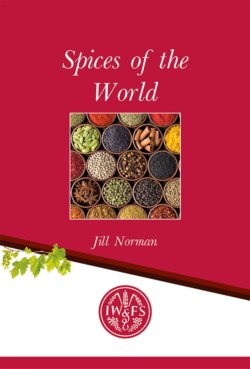Читать книгу Spices of the World - Jill Norman - Страница 5
На сайте Литреса книга снята с продажи.
Оглавление1. Using spices at home
Understanding how best to store spices at home, and how to use them in cooking, can be complex
Always use spices sparingly, either alone or combined with other spices or herbs. It is best to buy whole spices and then grind them as needed. All spices lose their oleoresins and volatile oils over time, and whole spices hold them for longer than ground.
All dry spices should be stored in a cupboard rather than on an open shelf. The best packaging for spices is small resealable foil pouches – when tightly closed they protect the contents from light and humidity.
Small airtight tins or dark glass or plastic pots are the next best containers, but even those with airtight lids have a space above the contents that allows air to enter.
Crush or grind
Use a spice or coffee grinder (but don’t also grind coffee in it) and grind to a powder as needed. Some spices need only to be crushed, and for this a pestle and mortar is best. Or, for a large amount, put the spices in a plastic bag, flatten it on a worktop and crush with a rolling pin. As before, don’t crush more than you need.
A few spices, such as dried galangal, are almost impossible to grind at home, so buy ground. Fresh ginger and galangal are best grated, while dry ginger and turmeric are very hard and are best grated on a rasp or a fine citrus grater. The Japanese use an oroshigane grater for wasabi.
“ It is best to buy whole spices and then grind them as needed ”
If you have spices that have been on the shelf for several months or longer, it is worth checking to see if they have retained their aromatic profile. Try breaking a piece of cinnamon, grinding a few seeds or crushing a cardamom pod – if you can’t smell the aroma then throw them away. Some ground spices can lose their aromatic qualities over the course of a few months.
Lemongrass, curry leaves and makrut lime leaves can be frozen in plastic boxes or tightly sealed bags and will keep for several months. Once thawed, use immediately.
Cooking with spices
Spices are frequently used in marinades, dressings, sauces, pastes and rubs. For the best results, grind the spices just before making the preparation.
Some recipes call for whole spices to be dry-roasted before use, particularly in Indian cooking. This concentrates the flavour and also makes the spices easier to grind. Heat a heavy-based pan on a medium heat until it feels hot when you hold your hand above the base, tip in the spices, then stir or shake the pan constantly.
The spices will darken, smoke a little and release their aroma. Lower the heat so they don’t burn; a tablespoon of spices will be ready in around two to three minutes, but a large amount can take several minutes to brown evenly. Tip the roasted spices into a bowl and leave to cool before grinding them.
“ If spices are added at the beginning of cooking their flavour will spread through the dish ”
If a recipe calls for frying spices, have all the other ingredients ready before starting because spices fry quickly. Use a heavy pan, heat the oil until a light haze rises, quickly tip in the spices – whole ones first – and use them in the sequence given in the recipe. They will sizzle and brown, but don’t let them burn.
Remember that if spices are added at the beginning of cooking their flavour will spread through the dish, but if they’re stirred through at the end of cooking then their aroma will be emphasised in the dish. Some spice blends are made using whole spices, which should be tied together in a muslin bag before adding to a pan of poaching liquid.
Most blends are mixtures of ground spices. Always make these in small quantities – don’t try to save time by making a large batch and storing most of it, unless you know you will use it again soon. Some common spice blend recipes can be found on p59. If you buy ready-made spice mixtures then purchase small amounts, and store in a small, dark container.
